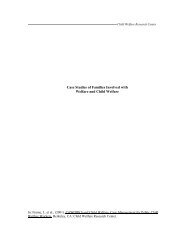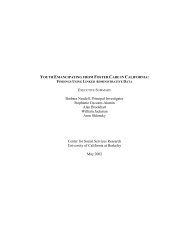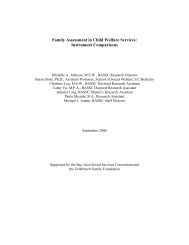However, race, ethnicity, and/or country <strong>of</strong> origin are not synonymous with culture. Theterm culture is much broader than racial and ethnic background, and includes sharedattitudes, behaviors, and traditions that are grounded in many other groupings, such as:sex or gender; stage <strong>of</strong> life (e.g., elderly); socioeconomic status; sexual orientation;religion; physical limitations or disabilities including impaired hearing; or literacy level.With this recognition, the term culture is used in this project in the more limited way, i.e.,most <strong>of</strong>ten referring to characteristics and experiences related to individuals’ racial andethnic backgrounds and/or countries <strong>of</strong> national origin.Culture influences the way we communicate with each other. Language is a method<strong>of</strong> communication that uses a system <strong>of</strong> sounds, symbols, and gestures that are organizedin a patterned way to express and communicate thoughts and feelings. Language is a part<strong>of</strong> culture and involves both verbal and written communications. Language dissonance(when two individuals—e.g., physician and patient—speak a different language) is onlyone type <strong>of</strong> language barrier that may be experienced in the health care setting. Othertypes <strong>of</strong> verbal communication barriers may include: lack <strong>of</strong> linguistic clarity (wherephysician and patient speak the same language, but an unfamiliar or heavy accent impedesunderstanding); limited or lack <strong>of</strong> health literacy (where health concepts conveyed by thephysician are unclear, or too complex, for patient understanding); or physician use <strong>of</strong>technical language or jargon (where medical terms used are unfamiliar to the patient,resulting in diminished or total lack <strong>of</strong> understanding).Regarding culturally appropriate health care, studies have shown that cultural factorsinfluence how individuals perceive the symptoms <strong>of</strong> illness, how they seek care when ill,and how they respond to treatment regimens (Saint-Germain and Longman 1993). Illnessbehavior directly affects the health system ins<strong>of</strong>ar as it influences the illnesses for whichpeople seek care, the timing <strong>of</strong> care, and the treatment process. Culture influences anindividual’s perception <strong>of</strong> the risk <strong>of</strong> becoming ill and the utility <strong>of</strong> treatment andprevention services (Frye 1993; Saint-Germain and Longman 1993). Cultural perceptions,thus, influence when a symptom is defined as a health problem, the severity <strong>of</strong> theproblem, and whether advice or care must be sought. Culture also contributes to anindividual’s understanding <strong>of</strong> the cause <strong>of</strong> disease. Understanding cultural perceptionsabout disease is critical to effectively engaging individuals in disease prevention andtreatment activities.Health care providers should recognize that in some cultures, Western medicine is<strong>of</strong>ten supplemented or mixed with traditional remedies. Therefore, if providers recognizethe need to provide treatment that is in some way compatible with traditional health carebeliefs, there is a greater opportunity for more effective care. Also, a provider’s awarenessabout his or her own values and how they may bias interactions with individuals fromdifferent cultures is viewed as key to providing culturally sensitive care (Dilworthandersonet al. 1993; Eliason 1993; May 1992). Price and Cordell (1994) suggest that providersCOSMOS Corporation, December 2003 2-3
assess their own beliefs and have knowledge <strong>of</strong> general ethnic, regional, and religiousbeliefs and practices before discussing health care issues with patients.Linguistically appropriate health care services—i.e., the provision <strong>of</strong> translatedwritten materials and oral interpretation services—are vital for a patient’s understanding,compliance, and positive health outcomes. Perhaps the most critical component <strong>of</strong> qualityhealth care is the patient’s ability to understand and be understood. Key consequences <strong>of</strong>language barriers in the health care setting include: 1) inadequate communication fromthe patient to the provider, making it difficult to relay a complete medical history or toaccurately report symptoms; and 2) inadequate communication from the provider to thepatient, which interferes with accurately informing (or educating) the patient about theillness and treatment (Woloshin et al. 1995).Also, studies suggest that accurate communication between patient and providerdecreases unnecessary diagnostic testing and increases proper diagnosis, patientcompliance, and the retention and use <strong>of</strong> appropriate services (National Committee forQuality Assurance NCQA 1995). Within this context, researchers raise several points inarguing the need for CLAS. When utilizing the health care system, non-English speakingindividuals encounter communication challenges that hinder access to care and effectivetreatment (Putsch 1985). In addition to language, researchers note that cultural issues arerelevant throughout the health care delivery system. Although some studies havesuggested reduced access to medical care may be due to language barriers or lowsocioeconomic status (Brach and Fraser 2000; Gany and Thiel de Bocanegra 1996; TheHenry J. Kaiser Family Foundation 1999), in other studies, the same disparities have beenobserved in racial and ethnic minorities <strong>of</strong> any socioeconomic status (Brach and Fraser2000; Smedley et al. 2002).Culture influences the way patients perceive illness (Landrine and Klon<strong>of</strong>f 1994;Landrine et al. 1994), seek care (Geissler 1991), and participate in and respond totreatment (McCormick 1993; Pilowsky 1993). Receipt <strong>of</strong> equal care may also be inhibitedby biases and stereotypes (HRSA 2000; The Henry J. Kaiser Family Foundation 1999;Smedley et al. 2002).2.1.4 CLAS Address Disparities in Health CareEvidence suggests that interaction <strong>of</strong> genetic differences, environmental factors, andhealth behaviors propagates health care disparities. These elements include biases <strong>of</strong>health care workers toward racial and ethnic minorities, lack <strong>of</strong> prevention messagestailored to specific populations, lack <strong>of</strong> physician awareness <strong>of</strong> higher risk factors for someillnesses in particular populations (HRSA 2000), lack <strong>of</strong> physician knowledge <strong>of</strong>traditional remedies and folk practices, and diagnostic errors due to miscommunication(Brach and Fraser 2000).COSMOS Corporation, December 2003 2-4
- Page 1 and 2: Developing a Self-Assessment Toolfo
- Page 3 and 4: ContentsChaptersPage1. Introduction
- Page 5 and 6: Chapter 1Introduction
- Page 7 and 8: While many LPHAs currently provide
- Page 9 and 10: LPHAs include: adult and child immu
- Page 11 and 12: Professions Education Partnership A
- Page 13 and 14: Chapter 2Methodology for Developing
- Page 15: Public Health Practice Program Offi
- Page 19 and 20: communicate with, and clearly under
- Page 21 and 22: 2.1.6 Identifying Key Components of
- Page 23 and 24: Given these persistent disparities
- Page 25 and 26: (Exhibit 2-2, Continued)DOMAIN / KE
- Page 27 and 28: limited to the actual clinical enco
- Page 29 and 30: Chapter 3Project Results and Recomm
- Page 31 and 32: local board of health. PEP and PAG
- Page 33 and 34: numerous promising CLAS practices a
- Page 35 and 36: References
- Page 37 and 38: Becker, M.H., and L.A. Maiman, “S
- Page 39 and 40: Frye, B., “Health Care Decision M
- Page 41 and 42: Marin, G., “Defining Culturally A
- Page 43 and 44: Perkins, Jane, “Overcoming Langua
- Page 45 and 46: U.S. Bureau of the Census, “Censu
- Page 47 and 48: Appendix AMembership Lists of the P
- Page 49 and 50: Appendix A-1Developing a Self-Asses
- Page 51 and 52: Appendix A-2Developing a Self-Asses
- Page 53 and 54: Appendix B-1Overview of Eight CLAS
- Page 55 and 56: Domain 3: Culturally Inclusive Heal
- Page 57 and 58: understanding of diversity issues i
- Page 59 and 60: Appendix B-2Conceptual Framework fo
- Page 61 and 62: Appendix CLPHA Director or Designee
- Page 63 and 64: Pre-Interview Script for LPHA Direc
- Page 65 and 66: 3b. Which of the following are refl
- Page 67 and 68:
6. Does your agency have a formal p
- Page 69 and 70:
10. Which of the following describe
- Page 71 and 72:
Post-Interview Script for LPHA Dire
- Page 73 and 74:
Appendix DStaffing Questionnaire
- Page 75 and 76:
A. QUALITY MONITORING AND IMPROVEME
- Page 77 and 78:
B. MANAGEMENT INFORMATION SYSTEMS (
- Page 79 and 80:
7. Please indicate, if you know, th
- Page 81 and 82:
1c. Please indicate for which categ
- Page 83 and 84:
6. Please indicate for which catego
- Page 85 and 86:
10. Which of the following topical
- Page 87 and 88:
17. Which of the following benefits
- Page 89 and 90:
4. Which of the following strategie
- Page 91 and 92:
Appendix EClient Services Questionn
- Page 93 and 94:
A. QUALITY MONITORING AND IMPROVEME
- Page 95 and 96:
6b.Which of the following community
- Page 97 and 98:
3. Please report or estimate what p
- Page 99 and 100:
3. Which of the following practices
- Page 101 and 102:
Oral Interpretation Services10. Whi
- Page 103 and 104:
16. At which of the following key e
- Page 105 and 106:
3. Which of the following kinds of
- Page 107 and 108:
Appendix FPilot Test Response Form
- Page 109 and 110:
RESPONDENT EVALUATIONOF THE QUESTIO
- Page 111 and 112:
Appendix GCLAS in MCOs Study Data C
- Page 113 and 114:
position, as titles will likely var
- Page 115 and 116:
complex and uncertain at the time t
- Page 117 and 118:
1. Incorporate a confirmation pre-c
- Page 119 and 120:
Exhibit 2DATA COLLECTION PROCESSSen
















